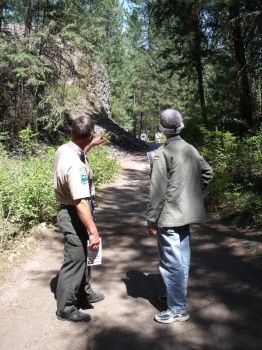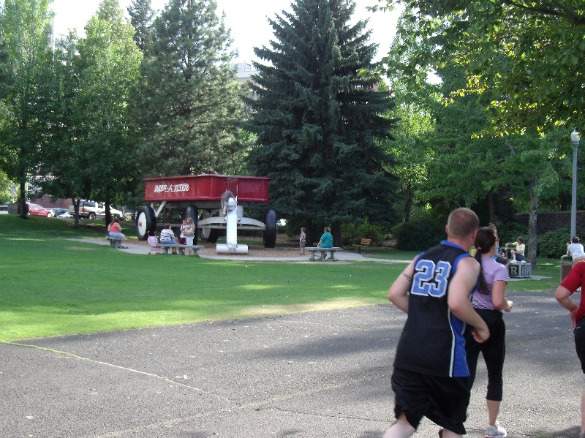I’m active in the great outdoors, as I’m an avid runner especially. But having also kayaked and hiked, I found these activities in Spokane, Washington have their own unique charm to them. There’s nothing like being out amongst the peacefulness of nature, especially if you can share it with others.
Hiking amongst the scent of Neapolitan ice cream
Did you know that if you go up to a Ponderosa Pine and smell the bark, you can smell such scents like that of vanilla, chocolate, and strawberry, flavors that make up Neapolitan ice cream? I tried this assertion out in Washington State’s 2nd largest state park, Riverside State Park, which covers 10,000 acres and was a gathering spot for Native Americans long ago. It’s in Spokane’s backyard, just northwest of the city, and has over 50 miles of hiking trails (including part of the 37 mile Centennial Trail). 600 acres are set aside for Off Road Vehicles. The Spokane and Little Spokane Rivers meet further north.
 I began my hike around the Bowl and Pitcher Overlook at the park’s south end, which offers stunning views of the Spokane River and camping opportunities. There’s a rocky fence to keep one from falling over into the abyss. Large basalt volcanic rock formations dominate the scene as well as the constant rumblings of the river, enjoyed by white water rafters. As I continued my hike downriver on a warm and partly cloudy day to another rock formation called The Devil’s Toenail, I kept an eye out for the various wildlife that others have spotted in this area, such as moose, bear, cougar, whitetail deer, mule deer, and even porcupine. I didn’t spot any, but there was still a feast for my eyes as they took in Ponderosa Pine, Douglas fir, and various plantlife at ground level, including poison ivy.
I began my hike around the Bowl and Pitcher Overlook at the park’s south end, which offers stunning views of the Spokane River and camping opportunities. There’s a rocky fence to keep one from falling over into the abyss. Large basalt volcanic rock formations dominate the scene as well as the constant rumblings of the river, enjoyed by white water rafters. As I continued my hike downriver on a warm and partly cloudy day to another rock formation called The Devil’s Toenail, I kept an eye out for the various wildlife that others have spotted in this area, such as moose, bear, cougar, whitetail deer, mule deer, and even porcupine. I didn’t spot any, but there was still a feast for my eyes as they took in Ponderosa Pine, Douglas fir, and various plantlife at ground level, including poison ivy.
Park Ranger Chris Guidotti guided me around on my hike, helping me to appreciate and take in the peacefulness of my surroundings. The trails are maintained well, though as I got closer to the river, it was rockier. One of Franklin Roosevelt’s Depression Era programs, the CCC, initially developed the park from 1933-36.
Park rangers serve a vital role to the public. Guidotti, a long time public servant in Washington’s state park system, shared me his simple philosophy of law enforcement in the park: to preserve the quality of the experience for guests, and protect the natural resources. Rangers like Guidotti have a passion for their jobs and it shows in the engaging way they come across. He’s the kind of person I would’ve liked to hike every mile of the trails with, had there been more time. Visitors can request tours and other information from the park rangers, though guided tours are given based on availability of staff.
In the “paddle steps” of David Thompson
Even though the eastern end of Little Spokane River Natural Area is a 35-40 minute drive north from downtown Spokane, that doesn’t keep the City of Spokane Parks & Recreation from organizing kayak trips along part of the 35 mile long river that runs through this preserve (for roughly 7.3 miles). It’s dominated by Ponderosa Pine and Douglas Fir. The Little Spokane River flows like a strand of spaghetti, but activities like swimming, inner tubing, and camping aren’t allowed, but kayaking is. The goal is to keep this area as undisturbed by man as possible, when it was purportedly explored by David Thompson and his guide Jacque Finley at the turn of the 19th century.
The 35 pound kayaks that we used are made of durable plastic. We navigated waters that had depths of less than a foot to 10 feet deep, and which had a nice constant flow. This helped make paddling easier on a brightly sunny and breezy morning, where the constant sound of Mourning Doves made for a memorable natural soundtrack to our adventure. We began near the property of a private school and headed downriver with our Recreation Leader Alicia, who gave us tips like staying clear of any moose and leaning into the bank when encountering obstacles like “sweepers” (fallen trees along the bank) if we found ourselves stuck there, so as to prevent capsizing. It worked!
Over the course of about 75 minutes, I caught the sights and sounds of much of Mother Nature’s offerings, including seeing a paddling of ducks close by trying to cross the river before I came up on them. Tule, plants that have tassels on their top and were used by the Spokane Indians for the making of baskets, roofs, etc., was commonplace on the shore of the river. I also saw a beaver heading to its dam along the shoreline while sighting a couple of Great Blue Heron. It’s great exercise for the upper body moving the paddle back and forth, yet in midst of such natural offerings, I found it a great way to relax while pleasantly chatting with others. We took our kayaks out just in front of the Indian Painted Rocks, which looked like graffiti from another time, and whose intended message basically remains a mystery.
Running with the locals made me an “instant member”
“Running with” someone in Northeast Washington State can mean something other than hanging out. Quite literally, it can mean running three miles (5k) every Thursday night beginning at 6pm through downtown Spokane via the Flying Irish Running Club. Anyone, including those visiting from out of state, can join for free…by just showing up, signing in, and running!
When I run at home, I normally run all by myself, so it was quite a unique experience running from O’Doherty’s Irish Pub to Mile marker 21 on the Centennial Trail (1.5 miles), and back to the pub with over 350 people though party cloudy and windy conditions. I got to see such sights as a very large Radio Flyer Wagon, the Gonzaga University campus, and the Spokane River. The runners meet up weekly generally from the first week in March through Thanksgiving, when the days are a bit longer and before winter conditions set in. One is allowed to run at one’s own pace, and for me and my new friend Ben, we managed to finish ahead of just over half the pack, some of whom were running with their dogs and baby strollers. Had I visited a week later, I could’ve been a part of their Irish Toga Party (200-plus ran the streets in togas).
After finishing, free ice water was waiting outside the pub, though many go inside to grab food and drinks as well as some social time with other runners. I’d never heard of such a club that lets one purchase a blue longsleeve shirt with the club name on it for $10 after completing six runs and telling an Irish joke inside the pub. After 33 runs, one can purchase the club’s tanktop for $15, but the most coveted shirt is the free one given out after 50 runs.
The author’s first Spokane article at Bootsnall.com. Biography: Roy A. Barnes is a frequent contributor to Bootsnall.com and writes from southeastern Wyoming.
Disclosure: I attended a press trip sponsored by the Spokane Regional CVB, but what I write is my own impressions and without scrutiny or vetting by the sponsor.


